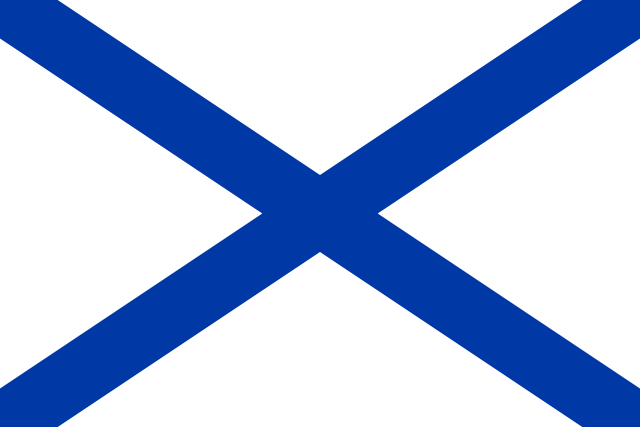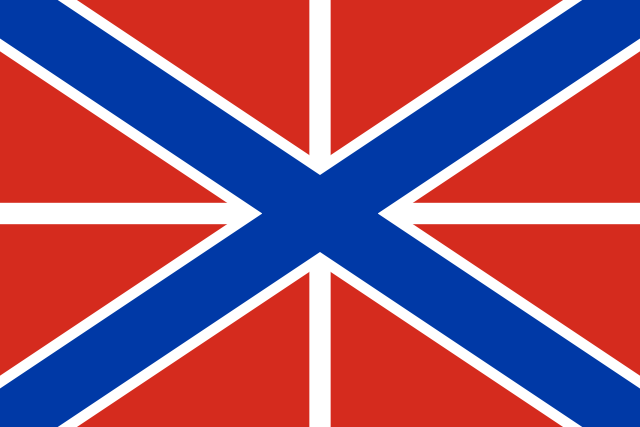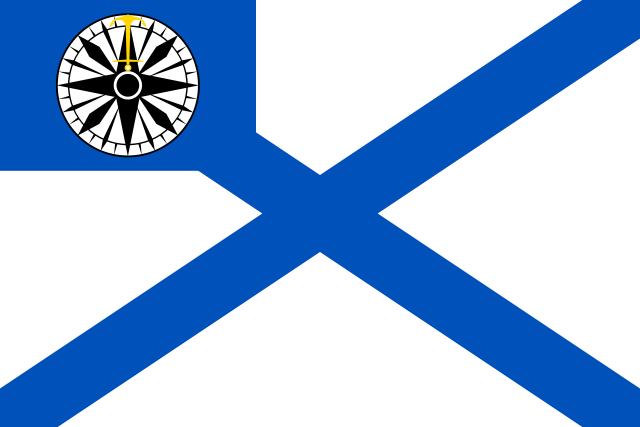11 December 1699 Peter I established the St. Andrew’s flag as the official flag of the Russian Navy

On December 1 (11), 1699, Sovereign Peter I Alekseevich established the St. Andrew flag as the official flag of the Russian Navy fleet. The main naval banner of the Russian Navy is a white, rectangular cloth, crossed diagonally from corner to corner with two blue stripes that form an oblique cross. The king explained his choice by the fact that it was from the Apostle Andrew the First-Called that Russia first received holy baptism, and he became its heavenly patron, and thus, Peter wanted to perpetuate the name of the saint.
The symbolism of the St. Andrew’s flag has deep roots. One of the disciples of Jesus Christ was Andrew - the brother of the Apostle Peter (Cythe, former Simon), the patron saint of Tsar Peter I. According to the Gospel, both brothers fished on the Lake of Galilee, that is, they were directly related to the sea. Andrew was first called by Jesus Christ to be his disciples, and therefore was called the First-Called. According to some sources, Andrew was sent for missionary activity in Scythia (Northern Black Sea region). A number of Russian sources reported on the journey of the Apostle from the Crimea to Rome through Ladoga. It is said that Andrew, making a stop on the hills near the Dnieper, where Kiev will be founded, informed the disciples that God's grace would shine here and a great city would be founded. He climbed the hills, blessed them and set up a cross. Then he visited the northern lands of Russia, marveling at the custom of the Slavs, who washed themselves in the baths, beat themselves with “young rods”, and poured kvass and ice water. Some sources report on the further journey of the Apostle Andrew to the north, where he erected a cross near the present Gruzino village on the banks of the Volkhov, to Lake Ladoga and a visit to Valaam Island. At the same time, it should be noted that many authors, including Orthodox church historians, question the existence of this journey.
One thing is certain, the Apostle Andrew became famous as a tireless traveler and preacher of Christianity. The missionary activity was closely related to the sea. The Golden Legend (a collection of Christian legends and the lives of saints, written in the 13 century) reports the salvation and even the resurrection of 40 travelers who were sent by sea to the apostle, but were destroyed by a storm (in another version it is reported to calm the sea by prayer). This can explain the veneration of Andrew the First-Called as the patron saint of sailors. His life was ended by a martyr's death - a crucifix on an oblique cross (which received the name of the apostle).
The veneration in the Russian state of the Apostle Andrew and the special attitude of Tsar Peter Alekseevich to him was also expressed in the fact that in 1698 the first Russian order was established - the Holy Apostle Andrew the First-Called. The main part of the order was the image of the Apostle Andrew, crucified on an oblique cross. St. Andrew’s order on the blue ribbon until 1917, remained the main and most honored award in the Russian Empire (since 1998, the highest award of the Russian Federation). It should also be noted that the symbolism of the St. Andrew’s flag came from the father of Peter, Tsar Alexei Mikhailovich, who established a special flag for the Orel ship built under him - a white, blue and red flag with a double-headed scarlet eagle.
Becoming a king, Peter Alekseevich paid much attention to the development of drawings of the flag of the Russian fleet. So, in 1692, two sketches were created. One - with three horizontal stripes and a caption: "white", "blue", and "red." The second drawings - the same colors are indicated with the “St. Andrew’s Cross” laid on them. In the 1693 and 1695 years, the flag of the second project was added to a number of European atlases as the "flag of Muscovy". I must say that in search of the final version of the naval flag of Russia, the king went over about two decades 30 projects. In August, 1693, Tsar Peter raised on an armed yacht “St. Peter "is a flag of three horizontal stripes (white, blue and red) with a golden eagle in the center. From this point on you can trace the development of the naval flag of the Russian state. Unfortunately, there is no information about the rulers of the Russian soldiers in the first millennium of our era, under which the ships of Novgorod merchants and ushkuyns floated. Although it can be assumed that the Russian battle banners were red from the deepest antiquity.
In 1696, during the second siege of the Turkish fortress of Azov, Russian ships carried a flag with a blue straight cross and quarters of white and red flowers aft. However, as early as next year, Tsar Peter established a new flag of the navy from three horizontal stripes - white, blue and red, actually returning to the 1693 variant of the year. Under this flag, the fortress ship sailed to Constantinople in 1699, with the first official diplomatic mission of the Russian Navy. At the same time, the Russian sovereign, who had just returned from a trip to Western Europe, continued to search for a drawing of the naval flag of Russia. In the autumn of 1699, for the first time, an "Andrew's" oblique blue cross appears on the white-blue-red cloth - a sign of the patron saint of Russia, the Apostle Andrew the First Called. He was also placed by the king and in the white head of the three-colored pennant known from 1697, which existed under the name of the “ordinary” year to 1870.
In 1700, Tsar Peter considered engravings and drawings of the 58-gun ship “Goto Predestination” (“God's Foreseeing”). On engravings by Adrian Schönebeck and on Bergman's watercolor, the warship is depicted with six different flags! One of the types shows a flag, in the cloth of which nine horizontal stripes of white, blue and red colors are successively arranged; on the other, a white-blue-red flag with three horizontal stripes (1697 variant of the year); on the third - a flag of seven stripes, on a wide white central band of which a black Andriy cross is placed, above this strip are narrow white, blue and red, and below it are narrow blue, white and red stripes. However, the king believes that the 1697 flag of the year is obsolete, and the nine-page panel is hard to read and, moreover, very similar to the Dutch flag of the rear admiral. The king is satisfied with the flags on the drawings: white, blue and red with Andrew’s blue cross in the upper quarter of the flag at the flagpole. This system was similar to that adopted in the English fleet. At the same time, galley fleet flags were established, differing from ship flags by the presence of kosits (flag ends in the form of right-angled triangles). In addition, white, blue and red pennants began to be raised on the masts of the ships, in whose white head a blue Andrew cross was placed. Blue and red flags and pennants, which are sometimes canceled and reintroduced into circulation, in general, they existed until the 1865 year. The white flag received a new design already in 1710 year - the blue Andreevsky cross was moved to the center of the cloth and as if hung in it, without touching the ends of the flag. The image of St. Andrew’s flag that we are used to in 1712 was adopted: a white flag with a blue St. Andrew’s cross. In this form, this flag existed in the Russian Navy until November 1917.
From 1720 on the bowsprit of the ships of the fleet of Russia, Guys began to rise - a special flag, which was previously used as the flag of the sea fortresses and called the “keyser-flag”. The red cloth intersected not only an oblique blue cross, but a straight white cross. It is believed that, he appeared in the 1701 year. Before 1720, the ships of Russia carried a reduced copy of the stern flag as a guys. The word "gueis" has an interesting history: it comes from the Dutch "goz", that is, a beggar. So in the 16 century the inhabitants of the Netherlands called the rebels against the Spanish rule. The largest group of Gyoz fought at sea ("sea gyoz") and began to use this flag for the first time.

Huys, flag of sea fortresses.
The primacy of the white flag, with the blue St. Andrew's cross, was finally enshrined in the Charter of 1797 of the year: "If the ships are not listed anywhere, carry white flags." At the same time, the ships of the Russian Black Sea Fleet from its foundation to 1918, sailed only under the white St. Andrew’s flags. Colored - blue and red flags, were canceled in the reign of Anna Ivanovna and Catherine the Great. In the Kryzhs (the top quarter of the flag at the flagpole), the blue and red flags from 1797 to 1801 (during the reign of Pavel Petrovich) were not placed by Andrew's flag, but by Huys, who for Emperor Paul I, who from his childhood wore the rank of admiral, had special value as a personal sign. It should be noted that it was the sovereign Pavel Petrovich who turned the old flags and banners from clothing items into military relics. In addition, under the sovereign Pavel, some Russian ships raised the red and white cross of the St. John flag for some time. This flag was created as a stern badge of the Maltese squadrons created by the newly made head of the Order of Malta. 16 December 1798, Paul I was elected Grand Master of the Order of St. John of Jerusalem and planned to create a fleet based in Malta, to ensure the interests of the Russian Empire in the Mediterranean and southern Europe. The flag was abolished after the death of Pavel Petrovich.
In the 19 century, several more stern flags will appear in the Russian Empire. So, back in 1797, the ships of the Marine Cadet Corps received a special fodder flag, where the emblem of the school was placed in the red flag of the center of St. Andrew’s flag. And on the main mast of the court of this school began to raise the "ordinary" pennants with tricolor braids. From 1827, the ships of the naval training crews were given the right to raise a special flag, where there was an image of a cannon and anchor (they were also placed in the red oval). Received their food flags and hydrographic vessels of the Russian Imperial Navy. In 1828, the “for the lot” flag was established, and on the Andreev flag in the center was a black compass pattern with a gold anchor pointing north. However, already in 1837, this flag was replaced by the flag of general hydrograph established in 1829. He had the same black compass coil, but in a blue little kryzha. In addition, 1815-1833's. there was also a stern flag for the ships of the Vyslensky military flotilla (Flag of the military courts of the Kingdom of Poland). It was the Andreev flag with a small red kryzhya, in which a white Polish eagle was placed. This flag was canceled after the defeat of the Polish uprising 1830-1831.

Flag of the General Staff Hydrograph. Flag of ships destined for sailing.
Auxiliary vessels of the navy of the Russian Empire until 1797 were carried aft with a tricolor flag and a bowspit huyus. From 1794 to 1804, the auxiliary ships were distinguished by a military pennant. And since May, 1804 has received a special flag with a white or blue cloth, with a roof of national colors (white-blue-red) and crossed anchors under it. In addition, an armed vehicle simultaneously carried a military pennant. All of these flags were canceled in 1865.
St. George pennant is a tricolor pennant with the flag of St. Andrew in the head, on the center of the cross of which a red shield is laid with the image of the patron saint of military men. George the Victorious, was established in 1819 year. He began to distinguish the Guards crew, who deserved this honor in the battle of the city of Kulm in 1813 year. Other differences that distinguished top officials were the St. George Admiral's flag (he had the flag of St. Andrew’s flag, but with the red shield of St. George), St. George's pennant and the flag flag of the rear admiral. In addition, during the Russian-Turkish war 1828-1829. The 74 gun battleship Azov (the hero of the Battle of Navarino) and the 18 gun brig Mercury (defeated two Turkish battleships) in the battles with the Turks especially distinguished themselves, they were marked by admiral flags of St. George, which were raised as stern. For the entire subsequent history of the Russian Empire, no other warship of the Russian fleet received such an award.
With the development of the country, changes also took place in the flags of the navy. In 1865, due to uselessness, blue and red flags and pennants were canceled. Also canceled everything except Andreevsky, stern flags. In 1870, the boat flags became the flag flags of the admirals, the "ordinary" pennant was eliminated, under which the ships that were not assigned to any part sailed. The pennant of St. George received instead of tricolor, white pigtails. In the same year, the blue flag, which had the image of the Andreev flag in the roof, became the stern flag of the auxiliary vessels of the Navy of Russia. In addition, as the armed forces develop, flags of ships of naval fortresses appear, new flags of officials, ships of individual units, ships of a separate Border Guard Corps, flags of the sea aviation.
The 1917 revolution of the year brought new symbols. Near the flags of St. Andrew began to raise red panels. Since the spring of 1918, the rise of the flag of St. Andrew’s on the ships of Soviet Russia was stopped. At the end of 1924, the Andreev flags were lowered and on the ships of the white fleet in Bizerte (the ships were laid by the French, they would soon be "let into needles"). Huys and the serf flag, with some changes - in the central part of the cloth in the white circle depicted a red star with a hammer and sickle in the middle, existed until 1932 year. In addition, during the Second World War, the symbolism of the St. Andrew’s flag was used by the collaborationist units of General Vlasov.
17 January 1992, the government of Russia adopted a resolution that returned the status of the Russian Navy flag to the St. Andrew’s flag. As a result, the pre-revolutionary St. Andrew’s flag and guis were restored in the Russian Navy and are still in effect.
Information